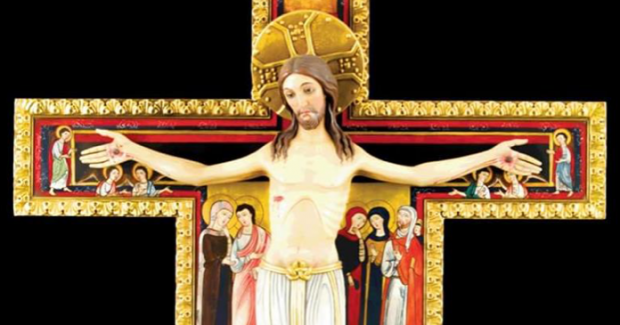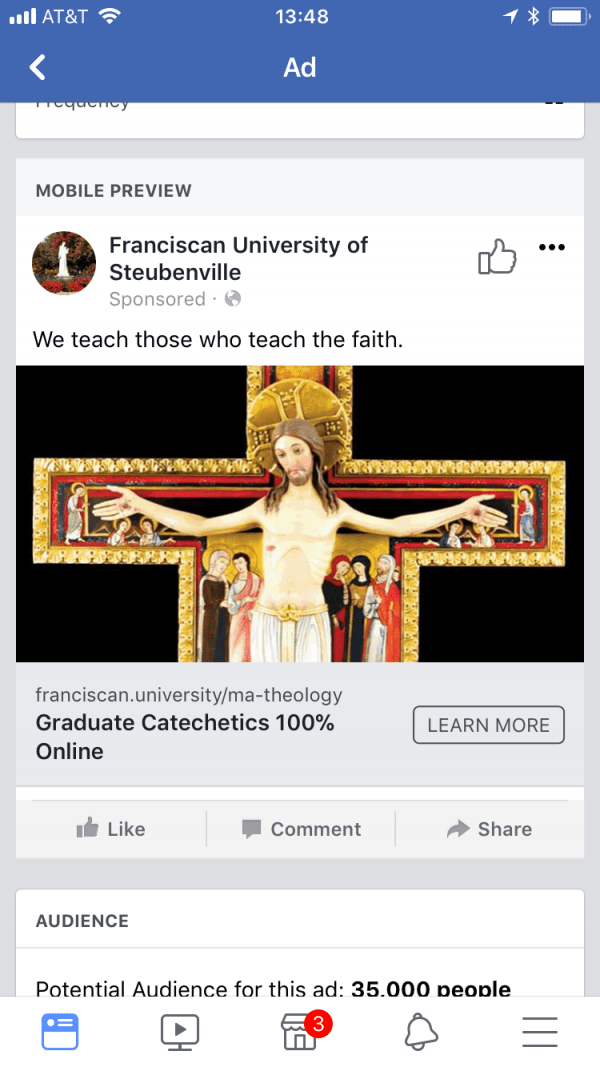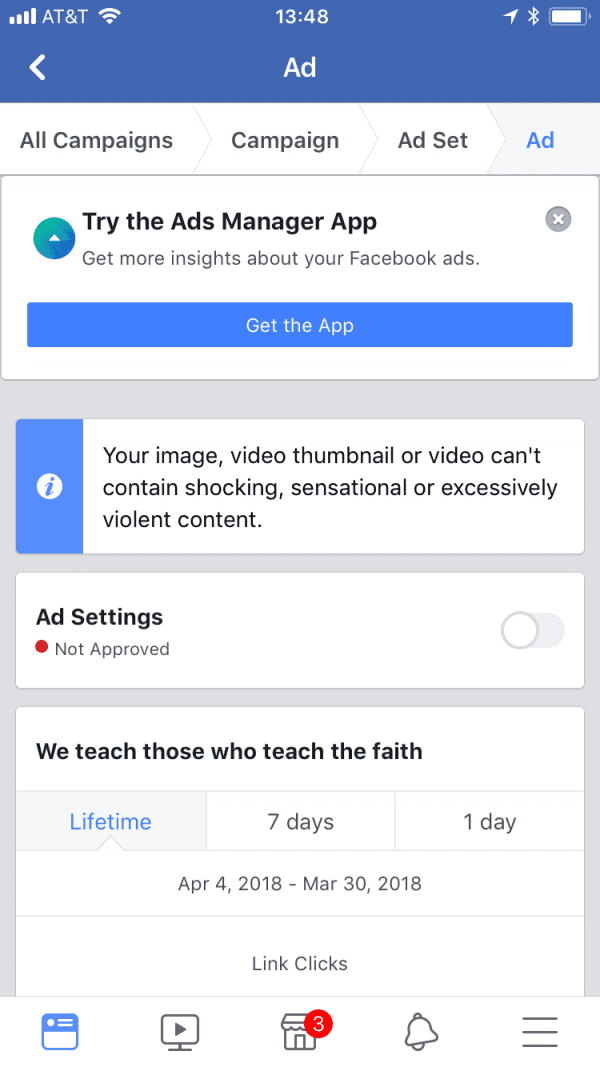Christianity: Too Violent For Facebook

A very disturbing piece of news from the Franciscan University of Steubenville, a Catholic college:
We posted yesterday a series of ads to Facebook to promote our online MA Theology and MA Catechetics and Evangelization programs.
One ad was rejected, and an administrator of our Facebook page noticed this rejection today. The reason given for the rejection?
“Your image, video thumbnail or video can’t contain shocking, sensational, or excessively violent content.”
Here is a screenshot of the ad:

And here is a screenshot of Facebook’s rejection:

There are two possible explanations, neither of them reassuring.
- This is an example of anti-Christian bigotry, flat-out.
- This is an example of religious and cultural illiteracy.
Since we’re dealing with Facebook, which is headquartered in the most religiously unobservant part of the US, I will assume in charity that it’s the second. This is still cause for alarm. Is it really the case that we have raised a generation of complete morons when it comes to religious and cultural literacy, such that they see the central symbol of the world’s biggest religion as nothing more than an expression of violence, and thus not to be tolerated? This is the stupidest example of “zero tolerance” I’ve ever heard of — and believe me, I’ve heard of quite a few.
Aside from that religious fact, the particular image that the university used is the San Damiano Cross, a medieval icon-style painting of the Crucifixion. It was while praying in front of this cross that St. Francis of Assisi is believed to have received his commission from God to “rebuild” the Church, which had fallen into corruption. It is impossible to overstate how important this image is to Western religious history. And yet, to the nitwit at Facebook who rejected the image as “shocking, sensational, or excessively violent,” it’s nothing but lines and colors.
Let’s give Facebook’s nameless content editor credit: he or she may well understand the Crucifixion more truly than do Christians for whom the murder of the incarnate God on a cross has gone from being a scandal to a banality. Facebook is right: the image is shocking, sensational, and excessively violent, because that’s what a crucifixion is! Yesterday in his Palm Sunday sermon (we Orthodox Christians observe Easter a week later this year), my priest said, “We don’t spend this week saying, ‘Those Jews did that to Our Lord.’ We spend it accusing ourselves. We did it to Christ. Every time we sin, we crucify Him. This is on us.” He’s right about that. It’s not a bad thing to be reminded how much He suffered in His body to liberate us from death. What the San Damiano Cross depicts is a murder. But for Christians, it also depicts the defeat of all murder and death, and the necessary prelude to eternal life for all. As we Orthodox sing on Pascha (Easter): “Christ is risen from the dead/Trampling down death by death/And upon those in the tombs bestowing life.”
A Christian culture would know that for the people who revere this symbol, they are looking at an image of death’s defeat, and of eternal life.
But we are no longer a Christian culture, and are becoming less so by the day.
This incident is alarming because of what it reveals about the kind of world that Christians are going to live in. Facebook is one of the most powerful media companies on the planet. If it decides that it will not approve Christian content because it finds that content violent, bigoted, or what have you, then that will have a tremendous potential effect, not only on the ability of Christians to communicate, but (more importantly) on shaping the way the Christian faith is regarded widely in this post-Christian culture.
Understand: Facebook is a very powerful company. Silicon Valley companies are globally powerful. And they almost certainly know next to nothing about Christianity, and what they do know, they despise as a bigoted ideology.
This matters.
As for me, this is probably the thing I needed to get off of Facebook. I almost never use it, and have been alarmed by the recent data mining revelations. If Facebook doesn’t want an image of the crucified Jesus on its platform, then it doesn’t want me either.
UPDATE: A number of you say that this ad could have been rejected by an algorithm. If that’s true, that is worrying too: decisions like this to ban religious imagery being made by machines.
UPDATE.2: A reader writes:
I see that you’re entertaining the “algorithm” hypothesis as a genuine third type of explanation of the flagging of the image, as opposed to explicit bias or lack of knowledge of the faith. I thought you might be interested in this post — something that got sent around my office recently. I don’t know the author, so I can’t speak to her reliability, etc.
https://aiweirdness.com/post/171451900302/do-neural-nets-dream-of-electric-sheep
The algorithm hypothesis is not in all cases a genuine third hypothesis: as the author points out, these algorithms often depend on human employees giving verdicts on a relatively small sample set of images. So, it could conceivably be that Facebook employees were tasked with labeling images as violent or non-violent, and their decisions determined how the algorithm thereafter labels images. It’s therefore possible that, through ignorance or bias, those employees labelled images of crucifixion as violent. Thus, even on the algorithm hypothesis, it would be appropriate to appeal to bias or ignorance in the explanation of how these images got flagged.
Two very important points:
1. I don’t know much about how these algorithms work. My company works in a different kind of AI, which focuses on teaching AI common sense reasoning.
2. Even if these algorithms work in the way I’ve described, it’s possible that neither bias nor cultural ignorance is to blame here. As the article I link to shows, these algorithms are often “fluky”. It might be that some human labelled a picture as violent that depicted a shirtless person with a side-wound. Then maybe the algorithm picks up on a similar pattern in the crucifixion image and labels it likewise.
Another reader writes:
I am what you would describe as a liberal, but I strongly appreciate your point of view and have taken it to heart in thinking about many of the issues that are discussed in the news today. I am a believer in our savior and I do agree that Christianity in many ways is under siege.
One thing I would like to point out on your Facebook post about the ad for the University being rejected, is to point out that these rejections are from a algorithm that evaluates photos. I run a small marketing company and have placed many ads on Facebook that get rejected inexplicably. These algorithms look at things like the amount of skin shown, limbs, and potentially blood or other visual elements. Looking at this picture of the machine perspective it could be almost anything.
It would be interesting to know if the University asked for a manual review of the ad, because this is the only way to get an actual person to look at the picture.
These algorithms control our lives and in many cases not for the better. I think this is an example, most likely of an inadvertent rejection. Just wanted you to be aware of the other possibility that this was not an anti-Christian issue. Not that Facebook should not be rightly accused of being in some way, an evil degradation of our society, but the possibility exists that this was unintentional.
Subscribe for as little as $5/mo to start commenting on Rod’s blog.